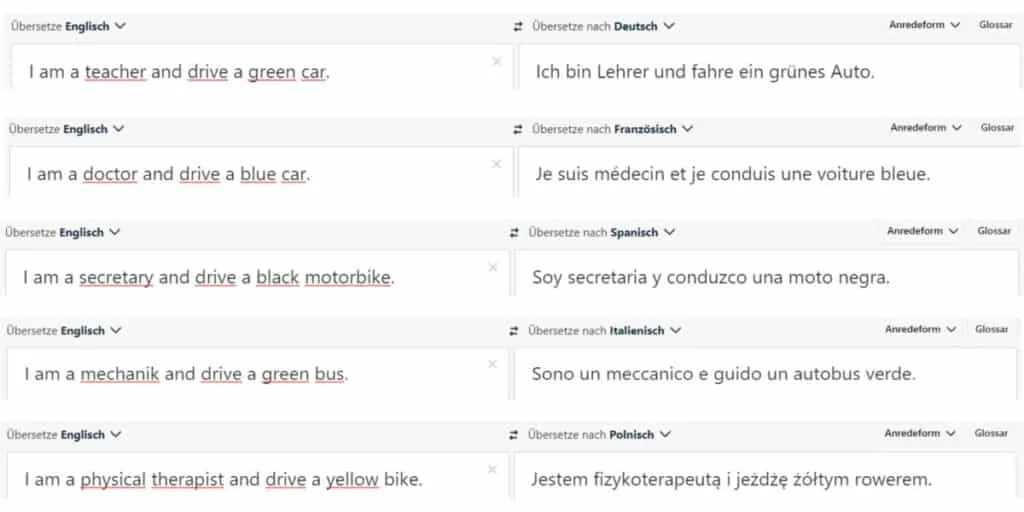Let’s be honest, no matter how good your foreign language skills are, every now and then it really helps to type a sentence into a translation tool like DeepL or Google Translate and get a machine translation, right? The problem: if you’re not well versed in the respective foreign language, you probably won’t notice if your AI tool delivers a result that would make any native speaker’s hair stand on end. One example is the much-discussed topic of “gender.” This clearly demonstrate how machine translation solutions can be useful in some cases, but exceedingly susceptible to error in others.
For example, if you translate an English phrase like “I went to the doctor yesterday” into German, nine times out of ten, you’ll get the result “Ich war gestern beim Arzt.” In other words, DeepL and other tools don’t seem to think much about emancipation or equality. Occupations are automatically “gendered,” in other words, assigned to a “typical” gender. We at ACT Translations have tried this out with a wide variety of professions and languages, but always came up with the same rather sobering results. A “nurse” automatically becomes a “Krankenschwester,” even though the English term “nurse” is commonly used for male nurses as well. The word “mechanic” ends up as “Mechaniker,” “mecánico” or “mécanicien” (all male), a “physical therapist” becomes “Physiotherapeutin” (female). The “professor” is, surprise, surprise, male, “housekeeper,” on the other hand, typically female.
The AI industry – white, male and not very diverse
So are concepts like deep learning, machine learning or AI testosterone-driven macho systems per se? Or why else don’t these tools suggest females terms like “Ärztin” or “KFZ-Mechanikerin”? The answer is complex. For one thing, the field of artificial intelligence is dominated by white, male scientists. According to the MIT Technology Review, only 18 percent of the speakers invited to leading AI conferences are women, while at Facebook and Google only 20 percent of AI professors and ten percent of research assistants are female. But that is only one small aspect of a larger problem.
AI is based on vast quantities of data
Machine learning systems certainly can be powerful tools, but they are only as good as the data fed into them. In other words, if there is a systematic error in the data used to train a machine learning algorithm, the resulting model will reflect this.
In most cases, this is not just a matter of bias or stereotyping. It is also not down to those people, who may have been superficial in selecting their data sets or training their models. No – inherent social distortions manifest in the results of machine translations, much like historical records of a society merely provide highlights of the overall situation. Datasets, in turn, pass on their bias – or superficiality – to the machine learning models that learn from them. If more men than women had been physicians in the past, any machine learning model trained on historical data would ‘learn’ that physicians are more likely to be male than female, regardless of the current gender distribution among physicians.
Typical language patterns instead of context
Machine translation models are trained using huge textual contexts. They include pairs of sentences that have already been translated once before. Added to this are linguistic nuances that often make it difficult to provide an accurate and direct translation. When translating from English into languages such as German, French, or Spanish, gender-neutral nouns are translated into gender-specific nouns. Although the word “friend” is gender-neutral in English, the term becomes “amiga” (feminine) or “amigo” (masculine) in Spanish. A human translator can ask: are we talking about a man or a woman? The machine translation tool is not in a position to ask for this context.
Challenge: communication and the spoken word
Things get really complicated when machine tools are used to translate speeches and the like. Spoken language can contain intonations, facial expressions, repetition, sarcasm, or irony that can completely change the meaning of a sentence. Modern machine translation solutions do not accurately reflect such nuances. There are other examples that show the limitations of translation tools. For example, if you type “cream of tartar” (a type of baking powder) into Google Translate, you get the literal German translation “Sahne von Zahnstein.” In the other direction: “Kernseife” used to end up as “nuclear soap” a few years ago. But in this particular example, the system has learned in the meantime and now translates it as “curd soap.”
Neural networks instead of statistical methods
Translation errors like this can be explained by the fact that Google Translate worked for many years with statistical translation methods that proceeded word by word and did not recognize correlations. Fails like this are far rarer today than they were a few years ago. Google Translate now relies on neural networks, i.e., artificial intelligence, to more accurately capture context for many of the more than 100 languages it has on offer. Scientists are also working flat out on the gender challenge.
A feel for language required
There’s no doubt about it! Machines work really well with structured language for specific applications. Examples include weather reports, financial reports, government minutes, or sports scores. However, there are many areas where these smart tools quickly reach their limits and human translators and language experts have to get involved. Anyone who has ever tried to translate a snappy marketing text by machine will quickly see that it simply doesn’t work! Thus, many customers of the perfume chain Douglas in Germany misunderstood their slogan “Come in and find out” to mean “Come in and find your way out again.” Legal texts should also be translated by experts rather than machines and then carefully proofread again to avoid misunderstandings – or even lawsuits.
The interplay of human and machine
Even though machine translation tools have become better and more accurate in recent years, and many studies have addressed gender-specific challenges in this regard, there is still a huge amount of catching up to do in this area – as there is in the entire field of gender research and equality. So it’s a good thing that human translators have the necessary linguistic skills and intuition to help out. And there’s nothing wrong with good interaction between humankind and machine, is there?







